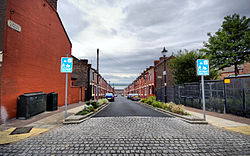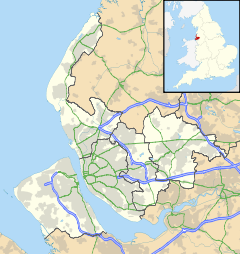- Dingle, Liverpool
-
Coordinates: 53°22′39″N 2°57′41″W / 53.3774°N 2.9613°W
Dingle 
Elswick Street, the filming location of the BBC TV series Bread.
 Dingle shown within Merseyside
Dingle shown within MerseysidePopulation 13,246 2001 Census[1] OS grid reference SJ355885 Metropolitan borough Liverpool Metropolitan county Merseyside Region North West Country England Sovereign state United Kingdom Post town LIVERPOOL Postcode district L8 Dialling code 0151 Police Merseyside Fire Merseyside Ambulance North West EU Parliament North West England UK Parliament Liverpool Riverside List of places: UK • England • Merseyside Dingle (known locally as the Dingle) is an inner-city area of Liverpool, Merseyside, England. It is located to the south of the city, bordered by the adjoining districts of Toxteth and Aigburth. At the 2001 Census, the population was recorded at 13,246.[1]
Contents
History
Dingle is an area entirely within the boundaries of the old Toxteth Park.
It is named after Dingle Brook (Dingle meaning a wooded valley), which rose at High Park Street and roughly followed Park Road, towards the Old Toxteth Chapel, just south of Dingle Lane and entered the River Mersey at Knott's Hole, which was a narrow bay or inlet next to where the Dingle flowed out to the Mersey. On either side were steep rocky cliffs, with Dingle Point to the south west. In the 1850s the Dingle area was purely rural. Liverpool lay to the north west, but this was an area of large houses, vast gardens, babbling streams and a long beach. It was a mainly Protestant area which developed from the influx of Welsh settlers, whilst the North end of Liverpool was settled by Irish immigrants, and became mainly Catholic.
Between 1896 and 1956, the Liverpool Overhead Railway's terminus and only underground station was Dingle railway station, located on Park Road, Dingle. This was the end of the line for services from Seaforth and Litherland in the north of the city.
Description
Dingle is the last of the southern inner-city districts of Liverpool. Further south of Dingle are the suburbs. This area is traditionally working class, housing being mostly terraced, although many of the terraced streets are being pulled down to make room for more modern development to attract wealthier middle class workers. In Liverpool this area is usually referred to as the Dingle.
Like many districts in Liverpool, there isn't universal agreement about where the Dingle begins/ends. The old township of 'Toxteth Park' covers a much bigger area encompassing Parliament Street, Lodge Lane, Smithdown Road, Penny Lane, Greenbank Road, Aigburth Vale, and St Michael-in-the-Hamlet. Some locals regard Dingle as being within the area encompassed by Warwick Street, in the north, Princes Road, Devonshire Road, and Dingle Lane. Some define the Dingle as above but only as far as Grafton Street and not to the bank of the Mersey, as this area was part of Liverpool Docks. The area between Admiral Street and Princes Road is known as Princes Park, after the nearby parkland.
Location filming for the BBC television series Boys from the Blackstuff written by Alan Bleasdale and also Bread, written by Carla Lane, was primarily in Dingle's Garswood Street and Elswick Street respectively. In 2007, residents in the Shorefields area of Dingle signed a petition to block plans for a new twelve storey residential development on the infilled Herculaneum Dock.[2]
Transport
The nearest railway stations are Brunswick for people living in the Grafton Street area and St Michaels for those living in the Dingle Lane area. Both stations are on the Northern Line of the Merseyrail system. Regular trains depart for Liverpool city centre, Southport and Hunts Cross.
Bus services are provided by Arriva, Stagecoach and Merseytravel
Notable people
References
- ^ a b "2001 Census: Dingle". Office for National Statistics. http://neighbourhood.statistics.gov.uk/dissemination/LeadKeyFigures.do?a=3&b=561308&c=dingle&d=14&e=16&g=358844&i=1001x1003x1004&m=0&r=1&s=1220893396343&enc=1. Retrieved 8 September 2008.
- ^ "People of ‘Bread streets’ likely to lose their view". Liverpool Daily Post. 14 April 2007. http://www.liverpooldailypost.co.uk/liverpool-news/regional-news/2007/04/14/people-of-bread-streets-likely-to-lose-their-view-64375-18902254/. Retrieved 8 September 2008.
External links
Districts and Wards of the City of Liverpool Districts Aigburth · Allerton · Anfield · Belle Vale · Broadgreen · Canning · Childwall · Chinatown · City Centre · Clubmoor · Croxteth · Dingle · Dovecot · Edge Hill · Everton · Fairfield · Fazakerley · Garston · Gateacre · Gillmoss · Grassendale · Hunts Cross · Kensington · Kirkdale · Knotty Ash · Mossley Hill · Netherley · Norris Green · Old Swan · Orrell Park · St Michael's Hamlet · Speke · Stoneycroft · Toxteth · Tuebrook · Vauxhall · Walton · Wavertree · West Derby · WooltonWards Allerton and Hunts Cross · Anfield · Belle Vale · Central · Childwall · Church · Clubmoor · County · Cressington · Croxteth · Everton · Fazakerley · Greenbank · Kensington and Fairfield · Kirkdale · Knotty Ash · Mossley Hill · Norris Green · Old Swan · Picton · Princes Park · Riverside · Speke-Garston · St Michael's · Tuebrook and Stoneycroft · Warbreck · Wavertree · West Derby · Woolton · Yew TreeCategories:- Districts of Liverpool
Wikimedia Foundation. 2010.


